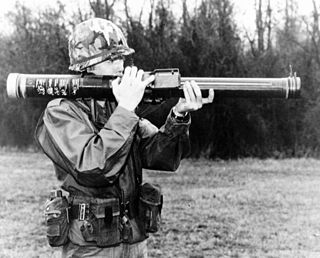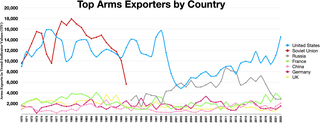Related Research Articles

The Northrop B-2 Spirit, also known as the Stealth Bomber, is an American heavy strategic bomber, featuring low-observable stealth technology designed to penetrate dense anti-aircraft defenses. A subsonic flying wing with a crew of two, the plane was designed by Northrop as the prime contractor, with Boeing, Hughes, and Vought as principal subcontractors, and was produced from 1987 to 2000. The bomber can drop conventional and thermonuclear weapons, such as up to eighty 500-pound class (230 kg) Mk 82 JDAM GPS-guided bombs, or sixteen 2,400-pound (1,100 kg) B83 nuclear bombs. The B-2 is the only acknowledged in-service aircraft that can carry large air-to-surface standoff weapons in a stealth configuration.

The Rockwell B-1 Lancer is a supersonic variable-sweep wing, heavy bomber used by the United States Air Force. It has been nicknamed the "Bone". As of 2024, it is one of the United States Air Force's three strategic bombers, along with the B-2 Spirit and the B-52 Stratofortress. Its 75,000-pound (34,000 kg) payload is the heaviest of any U.S. bomber.

The Wassenaar Arrangement on Export Controls for Conventional Arms and Dual-Use Goods and Technologies is a multilateral export control regime established on 12 July 1996, in Wassenaar, near The Hague, Netherlands. According to the Wassenaar Arrangement document, it was "established to contribute to regional and international security and stability by promoting transparency and greater responsibility in transfers of conventional arms and dual-use goods and technologies, thus preventing destabilizing accumulations. Participating states seek, through their national policies, to ensure that transfers of these items do not contribute to the development or enhancement of military capabilities which undermine these goals, and are not diverted to support such capabilities".

Anti-aircraft warfare is the counter to aerial warfare and includes "all measures designed to nullify or reduce the effectiveness of hostile air action". It encompasses surface-based, subsurface (submarine-launched), and air-based weapon systems, in addition to associated sensor systems, command and control arrangements, and passive measures. It may be used to protect naval, ground, and air forces in any location. However, for most countries, the main effort has tended to be homeland defence. Missile defence is an extension of air defence, as are initiatives to adapt air defence to the task of intercepting any projectile in flight.

An autocannon, automatic cannon or machine cannon is a fully automatic gun that is capable of rapid-firing large-caliber armour-piercing, explosive or incendiary shells, as opposed to the smaller-caliber kinetic projectiles (bullets) fired by a machine gun. Autocannons have a longer effective range and greater terminal performance than machine guns, due to the use of larger/heavier munitions, but are usually smaller than tank guns, howitzers, field guns, or other artillery. When used on its own, the word "autocannon" typically indicates a non-rotary weapon with a single barrel. When multiple rotating barrels are involved, such a weapon is referred to as a "rotary autocannon" or occasionally "rotary cannon", for short.

Anti-tank warfare originated during World War I from the desire to develop technology and tactics to destroy tanks. After the Allies deployed the first tanks in 1916, the German Empire introduced the first anti-tank weapons. The first developed anti-tank weapon was a scaled-up bolt-action rifle, the Mauser 1918 T-Gewehr, that fired a 13.2 mm cartridge with a solid bullet that could penetrate the thin armor used by tanks at that time and destroy the engine or ricochet inside, killing occupants. Because tanks represent an enemy's strong force projection on land, military strategists have incorporated anti-tank warfare into the doctrine of nearly every combat service since. The most predominant anti-tank weapons at the start of World War II in 1939 included the tank-mounted gun, anti-tank guns and anti-tank grenades used by the infantry, and ground-attack aircraft.

Stealth aircraft are designed to avoid detection using a variety of technologies that reduce reflection/emission of radar, infrared, visible light, radio frequency (RF) spectrum, and audio, all collectively known as stealth technology. The F-117 Nighthawk was the first operational aircraft explicitly designed around stealth technology. Other examples of stealth aircraft include the B-2 Spirit, the B-21 Raider, the F-22 Raptor, the F-35 Lightning II, the Chengdu J-20, and the Sukhoi Su-57.
Hunter-Killer is an unofficial project name based upon an Aviation Week & Space Technology article. The U.S. Air Force's Hunter-Killer program was a tactical unmanned combat air vehicles (UCAV) procurement program. The General Atomics MQ-9 Reaper, a variant of the MQ-1 Predator won the project and was deployed in Afghanistan.

A hardened aircraft shelter (HAS) or protective aircraft shelter (PAS) is a reinforced hangar to house and protect military aircraft from enemy attack. Cost considerations and building practicalities limit their use to fighter size aircraft.

9K114 Shturm – is a SACLOS radio guided anti-tank missile system of the Soviet Union. Its GRAU designation is 9K114. Its NATO reporting name is AT-6 Spiral. The missile itself is known as the 9M114 Kokon (Cocoon).

The Japanese defense industry is the part of the Japanese economy responsible for the procurement of military technology, primarily for the nation's own Self-Defense Forces, largely due to a strict policy on national exports.

Industrial warfare is a period in the history of warfare ranging roughly from the early 19th century and the start of the Industrial Revolution to the beginning of the Atomic Age, which saw the rise of nation-states, capable of creating and equipping large armies, navies, and air forces, through the process of industrialization.
Confidence-building measures (CBMs) or confidence- and security-building measures (CSBMs) are actions taken to reduce fear of attack by both parties in a situation of conflict. The term is most often used in the context of armed conflict, but is similar in logic to that of trust and interpersonal communication used to reduce conflictual situations among human individuals.

Military relations between Israel and the United States have been extremely close, reflecting shared security interests in the Middle East. Israel is designated as a major non-NATO ally by the U.S. government. A major purchaser and user of U.S. military equipment, Israel is also involved in the joint development of military technology and it regularly engages in joint military exercises with United States and other forces. The relationship has deepened gradually over time, though, as Alan Dowty puts it, it was "not a simple linear process of growing cooperation, but rather a series of tendentious bargaining situations with different strategic and political components in each."
The Lightweight Small Arms Technologies (LSAT) program is funded by the U.S. Joint Service Small Arms Program, with the goal of significantly reducing the weight of small arms and their ammunition. Following a series of military programs to investigate advances in small arms, the LSAT program is the US military's latest project to replace existing US small arms. Tactical concepts and the research from the previous small arms programs indicates that lightening small arms is the first significant step towards increasing soldiers' lethality and survivability.

A precision-guided munition (PGM), also called a smart weapon, smart munition, or smart bomb, is a type of weapon system that integrates advanced guidance and control systems, such as GPS, laser guidance, or infrared sensors, with various types of munitions, typically missiles or artillery shells, to allow for high-accuracy strikes against designated targets. PGMs are designed to precisely hit a predetermined target, typically with a margin of error that is far smaller than conventional unguided munitions. Unlike unguided munitions, PGMs use active or passive control mechanisms capable of steering the weapon towards its intended target. PGMs are capable of mid-flight course corrections, allowing them to adjust and hit the intended target even if conditions change. PGMs can be deployed from various platforms, including aircraft, naval ships, ground vehicles, ground-based launchers, and UAVs. PGMs are primarily used in military operations to achieve greater accuracy, particularly in complex or sensitive environments, to reduce the risk to operators, lessen civilian harm, and minimize collateral damage. PGMs are considered an element of modern warfare to reduce unintended damage and civilian casualties. It is widely accepted that PGMs significantly outperform unguided weapons, particularly against fortified or mobile targets.

A main battle tank (MBT), also known as a battle tank or universal tank or simply tank, is a tank that fills the role of armour-protected direct fire and maneuver in many modern armies. Cold War-era development of more powerful engines, better suspension systems and lighter composite armour allowed for the design of a tank that had the firepower of a super-heavy tank, the armour protection of a heavy tank, and the mobility of a light tank, in a package with the weight of a medium tank. The first designated MBT was the British Chieftain tank, which during its development in the 1950s was re-designed as an MBT. Throughout the 1960s and 1970s, the MBT replaced almost all other types of tanks, leaving only some specialist roles to be filled by lighter designs or other types of armoured fighting vehicles.

Program Executive Office Soldier is a US Army organization that is responsible for rapid prototyping, procurement, and fielding of equipment for the soldiers.

An arms race occurs when two or more groups compete in military superiority. It consists of a competition between two or more states to have superior armed forces, concerning production of weapons, the growth of a military, and the aim of superior military technology. Unlike a sporting race, which constitutes a specific event with winning interpretable as the outcome of a singular project, arms races constitute spiralling systems of on-going and potentially open-ended behavior.
The defense industry of Israel is a strategically important sector and a large employer, as well as a major supplier of the Israel Defense Forces. The country is a large exporter of military equipment, accounting for 2.1% of the world total in 2024. Three Israeli companies were listed on the 2022 Stockholm International Peace Research Institute index of the world's top 100 arms-producing and military service companies: Elbit Systems, Israel Aerospace Industries and RAFAEL. It is also a major player in the global arms market with a 2.3% share of the global exports of major arms as of 2023. Total arms transfer agreements topped $12.9 billion between 2004 and 2011. There are over 150 active defense companies based in the country with combined revenues of more than $3.5 billion annually. Israeli defense equipment exports reached $7 billion in 2012, making it a 20 percent increase from the amount of defense-related exports in 2011. With the Russian invasion of Ukraine, arms exports reached $12.5 billion in 2022. Much of the exports are sold to the United States and Europe. Other major regions that purchase Israeli defense equipment include Southeast Asia and Latin America. India is also major country for Israeli arms exports and has remained Israel's largest arms market in the world.
References
- Paul Kennedy, The Rise and Fall of Great Powers (London: Fontana, 1989).
- Peter Mathias, First Industrial Nation: An Economic History of Britain 1700-1914 (London, 1969).